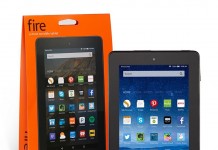
Q: I don’t see real page numbers in my Kindle books. Shouldn’t they be there now?
A: That depends on several things:
1. Are you using a Kindle 3?
I have no idea whether Amazon will upgrade older Kindle software for Kindle 2 and DX’s to have these. I would think they’d be included eventually. Amazon often takes 6 months to get to the old Kindles with updated software and it’s been longer than that for some changes that should have been added to the DX Graphite at least. The Kindle 1 with its different type of screen probably would not be updated, as the added calculations could slow down more that slower model.
2. Is your Kindle 3 using Update v3.1 ?
Press Menu button, then Settings, and your software version no. will be at the bottom right. If by now, you don’t have v3.1, I’d call Customer Support at 866-321-8851 but if you’re outside the U.S., try Call me, which is able to call back people in several countries but provides an email form if your country is not on the Call-me list. Ask them to help you with it, if a manual download (rather than automated) is required at this point. Sometimes, they can send one to your Kindle, if the update should have been sent earlier.
If you’re comfortable with using your Kindle’s USB cable (that is part of your power cord), to download an update and put it on your Kindle, see this blog’s article on software update v3.1 for information on how to do that.
3. If you have Kindle 3 with v3.1 software, have you tried pressing Menu button?
That is the only way to see the real page numbers. Amazon decided to keep the location and real-page numbers out of the way and showing only the percentage of the book you’ve read so far. Press Menu and you’ll see the page number *IF* Amazon has added them to that book..
4. Most Kindle books don’t have page numbers yet.
Amazon is adding page numbers to books and they definitely prioritize them.
The books must be matched to a specific printed edition and its ISBN #.
If a book has been processed by Amazon to add real-page numbers, this information will show up in the product page’s Product Detail (you need to scroll down a bit to see that).
In their original announcement, they said they’ve ““added real page numbers to tens of thousands of Kindle books, including the top 100 bestselling books in the Kindle Store that have matching print editions and thousands more of the most popular books.””
They’ve continued adding them at a fast pace, from what I read a couple of weeks ago, and they include the usual publishers and also university press books.
5. NON-Amazon books definitely won’t have them, as Amazon can’t calculate page numbers on books they don’t have on their servers.
Amazon wrote the following in a Kindle Post Daily over a month ago.
‘ We created algorithms to match the text of print books to Kindle books and organized all of this in the cloud, using our own AWS platform. The results of this work are stored in Amazon’s Simple Storage Service, where we track the complete history of every page matching file we’ve produced.
We even found a way to deliver page numbers to books that customers had already purchased – without altering those books in any way, so customers’ highlights, notes, and reading location are preserved exactly as they were.
Some other e-bookstores have added virtual “page numbers” to e-books, but we’ve found that these approaches can be confusing and often inconsistent – they don’t map to the page numbers in physical books, and in some cases they don’t account for title pages, blank pages, and other nuances that we see in print books.
‘ [ Andrys’ note here: Sony and iBook page numbers don’t map to print-book pages. ] ‘
… We want you to lose yourself in the reading, so page numbers are only displayed when you push the menu button… ‘
Via Andrys Basten’s A Kindle World blog

































The majority of other book reading devices do have page numbers.
My current reader and my previous reader simply calculate how many screens the book needs given current font type, font size, line spacing, paragraph spacing, margin size. Those are not “real” page numbers, but people are not asking for “real” page numbers. They are asking for something that resembles page numbers in books, instead of arcane “locations”.
I can’t understand why Kindle doesn’t have such option. It is very easy to implement in software.
Personally I have absolutely no interest in page numbers whatsoever. The only reason I have ever ever taken an interest in page numbers is to remember where I was in a paper book when I didn’t have a bookmark handy.
What I WOULD like is the ability to save ‘multiple’ bookmarks in the form of ‘tabs’ in my eBooks. The reason ? because sometimes both I and my partner or son are reading the same eBook simultaneously.
There were plenty of people asking for real page numbers on Amazon’s Kindle forum. They wanted to be able to cite from the Kindle.
For non-Amazon books and Amazon books without page numbers, calibre has a plug-in which will generate the apnx file required to show quasi page numbers. They’re an approximation of ‘real’ page numbers.
Howard, if you have multiple people using the same ereader, each of you could just leave a note with your initial at your last location.
where does one get that Calibre plugin? I’d love to have it… of course, I’d have to re-add all my books to make it work, but in some cases it might be worth it.
Name (required)
Yes, and as I mentioned, most of the other e-readers don’t have page numbers that map to a print-book’s pages, which is important to college classrooms and to bookclub members. The call for “real” page numbers has been enormous on the Kindle forums.
It’s strange to me, as I have never had a problem with location #’s — they’re just larger numbers and are more specific and ALWAYS go to a certain paragraph no matter the size of the font.
They are reliable for finding a spot when comparing contents with other humans.
The percentage line helps you gauge how far into the book you are. Virtual page numbers will suit those who want comfortable emulations of the page #’s they’re used to but they’re not useful for getting to certain points in fairly-important circumstances like classrooms, which, more and more, are turning to e-books except that the lack of useful citations has been a big drawback with e-books.
As for why Amazon didn’t implement virtual page #’s on the Kindle, they have actual smaller-interval’d numbers and it does amaze me that people can’t deal with 4 numbers instead of 3, when the system makes your number actually always go to a specific paragraph rather than the meaningless virtual, but comfortable 3-number ‘page’ number, the definition of which depends on the size of one’s font and line spacing.
Howard, if you’re using a Kindle, you can do multiple bookmarks, but they wouldn’t be readily identifiable as to the owner/maker of the bookmark.
What you can do instead is make a ‘moving’ “note'” which can consist of just your initials, prefaced maybe by an ‘x’ if the initials would form a common word — with the ‘x’ making it not common and therefore easily findable as unique during a search.
Each time you stop reading a book you’d delete the previous note (though you don’t have to — you can just look for your latest one with your initials). You can use Search and put in your initials and that would find each instance. It’d be best if you had only one, for speedier access to where you stopped reading.
Do a Menu/View Notes etc to check your Notes made or do a Search for the initials and then you’d essentially have your own bookmark.
Nice idea Andrys and Dianne, tks.
I guess the best solution ultimately, and one that I think is justified by the likelihood of multiple users of eReaders in a house, is to have multiple personalities at login, or multiple ‘readers’ when opening any eBook. I know that one or two of my friends share with wives and daughters, and I suspect this is is not unusual.
Howard,
The recommended thing is turn off synchronization between Kindle devices at http://amazon.com/manageyourkindle (which is found or linked at the bottom).
For people sharing a book it’s saner. Then your kindle gets your last-page read, and your family members get their own last-page read on their Kindles.
This works best, unless you decide you want to sync to your smart phone too 🙂 which lot of people do!
(The blurry, double-image Captchas today (99% of them) are driving my eyes batty.]
“(The blurry, double-image Captchas today (99% of them) are driving my eyes batty.]”
There are at least 6 much better alternatives to this captcha cr@p but Teleread won’t entertain them 🙁
Howard,
I misunderstood. I thought your household had different Kindles used by others, but you seem to be saying you’re all using the same Kindle.
There’s no log-in on the Kindle (except for a password if you want, but that doesn’t affect any individual bookmarks). But, yes, in multiple-Kindle situations all on one account, people just use their own Kindles and they turn off synchronization as I mentioned, if they are reading the same book, which lets them each use their own last-page-read, annotations, etc. They can share the same e-book, depending on the publisher’s limit as to how many can share an e-book on one account (normally up to 6).
I have a blog entry on it at http://bit.ly/kwshare
becca: the calibre plugin is called ‘APNX Generator’ and can be found at http://www.mobileread.com/forums/showthread.php?t=126220
@ Dianne: Thank you!